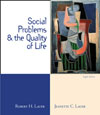CHAPTER 13 Family Problems Is the Family Doomed? (pp. 436-440) The popular and professional literature continue to forecast the death of the
family, but most sociologists view alternate forms of family as different ways
for people to express their intimacy needs. Among the important changes in American
families are increases in the age at first marriage, the proportion of young
adults remaining single, divorced adults, adults living alone, unmarried couples,
families maintained by adults with no spouse present, children living with only
one parent, wives and mothers working, and dual-career families. The functions
of family have also changed over time. The Extent of Family Problems (pp. 440-447) The family becomes a problem when it does not fulfill its purposes, particularly
its purpose as a primary group. Structural problems relate to the breaking up
of husband and wife or parent and child. Supportive problems or failure involve
the emotional support or lack of support of each family member. Although these
problems are difficult to measure, divorce rates, family violence, and parental
rejection by youth are useful indicators. Poverty, deviant behavior, antisocial
conduct, interpersonal difficulties, and low self-esteem may be by-products
of a disturbed family life characterized by structural or supportive failure. Family Problems and the Quality of Life (pp. 447-454) How family problems affect the quality of life is sometimes obvious and sometimes
not. There are various physical and emotional difficulties that are rooted in
family arrangements. Most single-headed families have a female head, and these
broken homes are much more likely to be affected by poverty than other homes.
There are various deviant behaviors associated with disturbed family life. People
who come from disturbed families tend to have various difficulties that may
be subsumed under the category of maladjustment. Contributing Factors (pp. 454-465) In terms of social structural factors, many of the social norms surrounding
family have changed; for example, the norms concerning divorce. A number of
role problems have been identified as important in marital dissatisfaction,
for they can contribute to both structural and supportive problems. Family continuity
is another consideration since many problems, like family violence, tend to
be continued from one generation to the next. As with all problems, there are
differences among families depending on the socioeconomic level: Divorce, for
example, is more common in the lower strata than in the middle and upper. Rapid
change of the social structure creates its own problems; for example, certain
kinds of change can affect the divorce rate. Among the social psychological
factors are attitudes toward various family forms and in terms of people's behavior
(as in cases of abuse), values, and homogamy. The American value of success
can lead to supportive failure in the family. The American ideology of the "good"
family generates a set of expectations; when those expectations are not met,
the result may be stress and dissatisfaction. What Is to Be Done? (pp. 465-467) The authors suggest both therapeutic and preventive measures in dealing with
family problems. Among the therapeutic measures are traditional counseling services
and small-group settings. Among the preventive measures are experimentation
with new family forms, good family life education, marriage enrichment programs,
and women's shelters for victims of battering. | 


 2002 McGraw-Hill Higher Education
2002 McGraw-Hill Higher Education